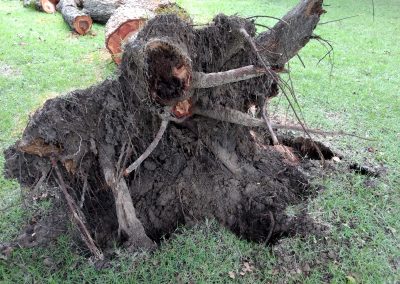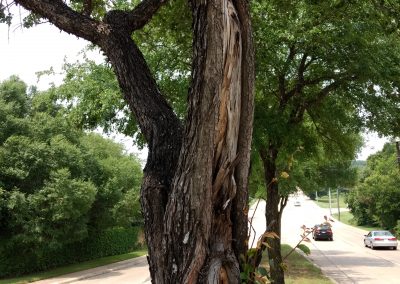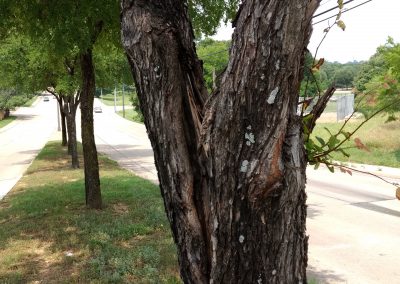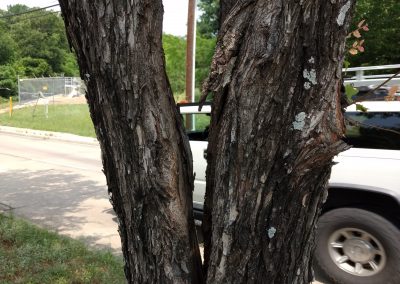We all enjoy the benefits of trees, and if you are a member or supporter of CTUFC then you probably appreciate the value of trees more than most. Unfortunately, trees sometimes develop issues that pose risks to people and property which need to be addressed. The reasons for addressing these issues include legal and financial implications, as well as social and aesthetic concerns. Tragedies sometimes occur involving trees and are made worse when there are children involved. A recent incident in Athens, TX serves as an unfortunate reminder. Trees can be deadly, which underscores the importance of timely inspection and proper tree maintenance. Of course, trees fall from storms but reducing tree failures under normal conditions can help give trees the good reputation they deserve. If you have a tree that is showing issues or signs of instability, please contact a certified arborist so that they can evaluate the tree and determine failure potential. Keep in mind that even the best trained arborist with the best equipment cannot fully predict the future of a tree. They will work with you to determine what level of risk you as the tree owner are willing to accept but keep other people and property in mind as well. Arborists with the Tree Risk Assessment Qualification, in particular, are trained in determining a risk rating using a standardized, industry-approved manner and communicating those ratings to tree owners. Hazardous trees are not worth someone’s life, so maintain, inspect, and mitigate risks so that trees can continue to be a positive feature in the landscape and provide shade, cooling, pollution reduction, stormwater runoff prevention, and other benefits.
What is a hazard?
The ISA defines a hazardous tree as one that has been assessed and found to be likely to fail and cause an unacceptable degree of injury, damage, or disruption (ISA Tree Risk Assessment Manual). This means that the tree has some likelihood of failure and likelihood of impacting a target, combined with the severity of actually hitting the target. A medium sized branch that is decaying and likely to fail may not be considered a hazard if it is located deep in the woods and would likely never hit anything but the ground if it fell. The same branch would probably cause concern if located over a playground at a daycare. However, not all situations are so easily assessed. After all, we live in a dynamic environment. The second consideration in the question of a target is the occupancy rate of the target: How often is a target present? While a large decaying limb hanging over a remote jogging path is hazardous, how often is there an actual target within the strike zone of the tree? That question also factors into the second part of the equation, not just can the tree hit something but what are the consequences of the impact? Public safety should always be an important factor, but for objects the consequence can vary. For example, the same decaying branch might have no consequence if it falls on a concrete bunker. Objects are easier to evaluate because they often remain in the same place, whereas determining if a person could be impacted by failure is much more difficult. Often arborists will look for objects that attract people to help determine if a person could be impacted. An example of this is evaluating the presence of sidewalks, picnic tables, playgrounds, pools, driveways, etc. to determine where a person could be in the event of tree failure. Tree owners should ask themselves: Could the tree hit something (person, pet, or property)? How often is the site occupied? What would happen if the target was hit?
What are some common tree conditions that increase risk?

The beginnings of this cedar elm splitting can be seen from the right angle, but many people would miss this sign of a potential issue. When caught at this stage, the tree can be saved with pruning and installation of bracing.
Splitting trunks and branches: This condition is one of the easier issues to spot and often can be mitigated through some combination of pruning and bracing to prevent further splitting. Splitting also gives an idea of the direction failure would occur, limiting the potential targets around the tree.
- Decay on the trunk or branch attachments: Decay is the ultimate result of disease, insects, or severe damage to the tree. It weakens the wood that supports the trunk and branches, increasing the risk of failure. This is harder to evaluate because it may not even be visible, and unlike splitting, decay doesn’t necessarily indicate the direction failure would occur.
- Damage to roots: Trees can have roots damaged, severed, or removed from construction or other changes to the rooting space. Root damage is difficult to determine as roots are not visible and the direction of failure is not predictable. Some studies have found a distance of 3 times the trunk diameter to increase failure potential (the tree is more likely to topple in a storm), but there is no guarantee that a tree is safe beyond this distance. In some cases, roots have been cut all the way to the trunk and somehow the tree remains standing, but the chances of survival are diminished.
- Leaning: Particularly if the tree is leaning towards a target, an off-center and off-balanced tree may pose a risk. Typically less than 15 degrees off vertical is not a cause for concern, but one should consider if this lean is increasing and if factors such as root damage also exist.
- Dead branches: If there are large dead branches (greater than 2-inch diameter) high in the canopy, you probably need an arborist to prune the dead branches and take a look at why the branches died. There could be other issues or the tree may be dying.
- Dead tree: Finally, any tree that is dead is a potential risk because it is no longer actively fighting decay. Even if the above-ground portion of the tree looks structurally sound, decay in the roots and root collar could cause the tree to fall. In some cases it may be possible to allow the tree to fall naturally, meanwhile providing wildlife habitat, but in most cities a dead tree is required to be removed. Especially in neighborhoods with houses all around, dead trees are usually considered a negative feature on a landscape depicting a lack of care.
What are some common tree conditions that do not increase risk?
- Bark damage without decay:
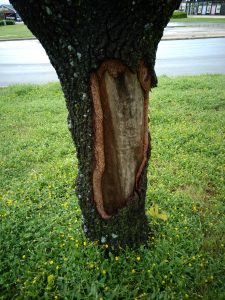
Strong wooded blackjack oak is very resistant to decay, so in this case of vehicle damage the trunk is still very strong.
Although the bark is extremely important to tree health and preventing decay, it has no real impact on the strength of the tree. The xylem located beneath the bark provides all the structural support for the tree.
- Small dead branches: Often defined as less than 1-2 inches in diameter, especially when low in the canopy, these branches might not cause harm.
What are other issues to look out for?
- Power lines: Although losing power is not ideal, the biggest concern is that a downed power line is a safety hazard itself. Treat power lines as potential target should the tree fail. Never prune a tree or branch that may be contacting a power line. If lines are contacting a tree or the ground, stay away and call your electric provider.
- Limbs over streets or blocking street signs: This is not a “hazard tree” in the usual sense, but low limbs near roadways could cause a dangerous situation.
- Limbs touching roofs: Limbs in contact with a roof (asphalt shingle roofs in particular) are not a safety hazard, but homeowners should watch for this issue. Prune the limbs 3-4 feet over the roof to prevent branches from causing a leaky roof.
What are my responsibilities?
Tree owners should maintain their trees to keep them safe and keep providing all of the benefits we love from our trees. If you aren’t sure about the condition of your tree, contact an arborist for help. As mentioned, cities usually do not allow potentially hazardous, or dead, trees to be retained on private property. Often, code violation notice stipulates a time limit to correct the situation, which makes finding mitigation options within the time constraint difficult. Checking trees themselves and by being aware of potential issues, tree owners can handle the situation in a timely manner without pressure to meet a deadline. In the case of tree removal, more time to shop around could mean a better price and a safer contractor (by checking references and safety records of the company).
Trees you own are not the only ones you should be concerned about, individuals should look at trees around their property, on their streets, in their parks, and elsewhere to help keep their neighborhoods and cities safe. Contact the tree owner or city if you see something that may be unsafe. Although people don’t want to lose their trees or be told that they may have a high risk tree, the alternative could be much worse.
Splitting cedar elm 1
Damage on a cedar elm from a previously split trunk. Cedar elm rarely experiences heavy decay from this type of damage, but the loss of wood structure increases failure potential.
Splitting cedar elm 2
The split on this cedar elm is quite severe, but in some cases may be remedied with pruning to remove one trunk or bracing the two stems.
Splitting cedar elm 3
In this case the tree was removed due its location and the severity of the splitting trunk. The main stem could not be left by itself because it was not strong enough without the codominant stems it previously had on both sides. The previously split off stem left a large wound that weakened the main trunk, which indicated bracing may not be able to hold the tree together.




